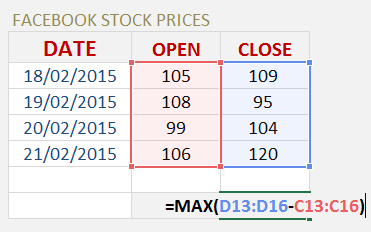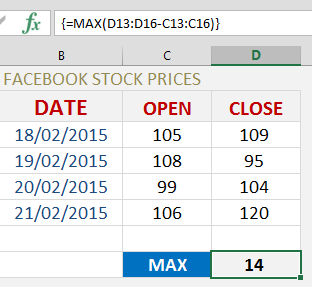An Array Formula performs an Excel operation (math, comparative, join or function argument) on an array or range of data. This could be a range of cells, a worksheet reference or a defined name.
An Array contains more than one cell, so you cannot perform an Array Formula on a single cell.
To turn your formula into an Array Formula, you will need to press CTRL+SHIFT+ENTER which will put the squiggly brackets {} outside the formula:
{=MAX(D13:D16–C13:C16)}
Let’s break down the different Excel operations that you can use to create an Array Formula:
MATH: +-*/()
COMPARATIVE: =<>
JOIN: &
FUNCTIONS: MAX, MIN, IF, INDEX, VLOOKUP etc
Let’s do an example of an Array Formula that calculates the maximum stock value change over a four day period:
Download excel workbookArray-Formulas-Intro.xlsx
STEP 1: Enter the MAX formula =MAX(
STEP 2: Subtract one array/range of data from another array/range of data =MAX(D13:D16–C13:C16)
STEP 3: Instead of pressing ENTER to evaluate the formula, you need to press CTRL+SHIFT+ENTER to turn the formula into an Array Formula which will look like this: {=MAX(D13:D16–C13:C16)}
STEP 4: By pressing F9 on the selected formula array will give you the resulting array of numbers (press CTRL+Z to get out of this mode when you are done checking the formula results):
If we had to get the above result using a non-Array Formula we would have to create a helper column which subtracts the Open & Close cells and then enter the MAX formula to reference these results. This is double the work!
Have a look at the following tutorial on the two methods:
John Michaloudis is a former accountant and finance analyst at General Electric, a Microsoft MVP since 2020, an Amazon #1 bestselling author of 4 Microsoft Excel books and teacher of Microsoft Excel & Office over at his flagship MyExcelOnline Academy Online Course.











